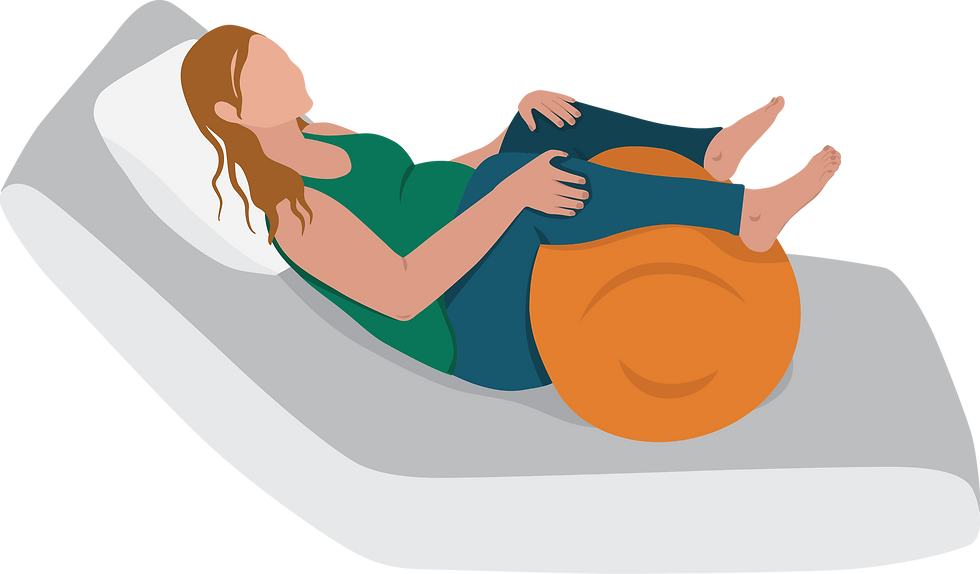How to Use Spinning Babies® with an Epidural
- Cheyenne Williamson
- Jun 3
- 3 min read
When you hear the words "Spinning Babies," you might picture a lot of movement, belly sifting, or wide hip circles on a birth ball—and you're not wrong! But what happens when a birthing person has an epidural and can’t move freely? Does that mean Spinning Babies techniques are off the table?
Not at all. In fact, many Spinning Babies® principles and labor positions can still be used with limited mobility, and they may make a significant difference in how labor progresses—even with an epidural.
As a birth doula, I've supported clients with epidurals and spent a lot of time learning how to adapt comfort measures when mobility is limited. I bring along both my book, A Doula’s Guide to Labor Positions, and what I’ve learned from Spinning Babies® to offer creative, supportive ways to keep labor moving—even with less movement.
Why Positioning Still Matters With an Epidural
Epidurals offer pain relief but limit lower body movement, which can slow baby’s descent or make it harder for them to rotate into an optimal position. Spinning Babies® is all about balance, space, and movement—three things we can still support with adapted positions.
The goal? Use gravity, asymmetry, and mindful positioning to keep labor flowing.
Adapted Spinning Babies-Inspired Positions for Epidurals
Here are some favorites I use often, all of which are featured (and illustrated) in A Doula’s Guide to Labor Positions:

Exaggerated Side-Lying
A deep, asymmetrical side-lying position that opens the upper mid-pelvis. With proper pillow support and alignment, this can encourage baby’s rotation and descent.
Great for posterior or asynclitic babies
Helps open the pelvis and create space without requiring mobility
Comfortable for resting while still promoting progress
Can be alternated from side to side every 20–30 minutes

Side-Lying with a Peanut Ball
A classic epidural-friendly option. This supported position uses a peanut ball between the knees to create asymmetry and keep the pelvis open.
Encourages baby’s rotation and descent
Supports pelvic balance and flexibility
Helps maintain labor progress while resting
Can be used throughout labor, switching sides every 30–60 minutes

Semi-Sitting
Adjust the hospital bed to a supported recline with knees bent and pelvis tilted—great for opening the sacrum and mid-pelvis.
Reduces pressure on the tailbone
Uses gravity to assist with descent
Offers a more upright option while still being supported
Easy to adjust with bed controls

Birth Ball Lean on Bed
Birth Ball Lean on the Bed
Adapted for epidurals, the ball is placed on the bed or tray table while the birthing person leans forward against it with support from the birth team.
Encourages fetal rotation through gentle rocking
Helps relieve back pressure
Requires assistance, but still allows for some movement
A great “active rest” option when mobility is reduced

Reclining on the Bed with Support Reclining on the Bed with Support
A low-effort position that supports alignment and rest while allowing room for baby to descend.
Opens the pelvic inlet and supports fetal engagement
Allows for rest without compromising positioning
Can be combined with a rebozo for gentle sacral support
Great transition position if upright options aren’t feasible
Tips for Using These Techniques
Switch sides regularly (every 30–60 minutes)
Use pillows and peanut balls to support good alignment
Involve your team: nurses, doulas, and partners can assist with safe adjustments
Bring a guide: My book offers visual cues and quick-reference tips that are perfect for use during labor, especially with limited movement
You Don’t Have to Choose Between Comfort and Progress
Choosing an epidural doesn’t mean giving up agency, movement, or intention. With thoughtful positioning and a supportive team, you can still work with your body and baby.
Whether you’re aiming for a VBAC, planning your first birth, or simply want tools that work with epidural support, A Doula’s Guide to Labor Positions is packed with adapted positions and the “why” behind them.
You deserve both comfort and progress—and you don’t have to compromise.




Comments